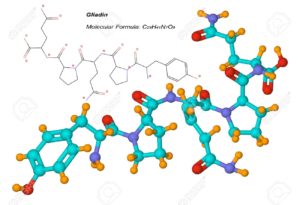
What Happens to Your Body When You Eat Gluten – Glue?
For Laser LipoMelt ReShape & application of this article call, Longevity Sciences LLC 612-703-4822
The word “gluten” has become a source of popular discussion in recent years! The popularity of the gluten-free diet has been endorsed by famous personalities. In this article you will learn about gluten, and how it can negatively impact your body and health!
What Is Gluten?
Gluten is a protein that’s made of glutenin and gliadin molecules that form an elastic bond in the presence of water. Adhesive properties found in gluten are responsible for holding bread and cakes together and giving them a spongier texture. This ability isn’t surprising, considering that the word “gluten” is derived from the Latin word for “glue!”
While it does wonders for these foods, the same cannot be said for your body. Research has shown that gluten can be quite harmful for you because of the vast range of complications it might cause. I call it “save your Mucosal lining and your gut Villi!!!”
What Does Gluten Do to Your Body?
Gluten interferes with nutrient breakdown and absorption from the foods we eat. This leads to the formation of a glued-together constipating lump in the gut that can prevent proper digestion. Afterwards, the undigested gluten prompts the immune system to attack the villi, or the finger-like projections lining your small intestine. Nutrients from your food must be absorbed through your tiny Villi’s! Side effects such as diarrhea or constipation, nausea and abdominal pain then arise.
Gluten consumption can also predispose people to increased damage and inflammation to the small intestine, causing nutrient mal-absorption, nutrient deficiencies, anemia, osteoporosis and other health problems. A damaged small intestine makes a person also susceptible to diseases that are not gastrointestinal in nature, such as neurological or psychological, and complications linked to the skin, liver, joints, nervous system and more.
What Are the Types of Food That Contain Gluten?
Gluten is predominantly found in whole grains like rye, barley, triticale and oats by processing contamination , and in wheat varieties like…..
- Spelt
- Kamut
- Farro
- Durum
- Products like Bulgar and semolina
High amounts of gluten are also found in these wheat-based flours and byproducts
Wheat-Based Flours
- White flour
- Whole wheat flour
- Graham flour
- Triticale
- Wheat germ
- Wheat bran
Wheat Byproducts
- Pasta
- Couscous
- Bread, bread crumbs and croutons
- Flour tortillas
- Cookies, cakes, muffins and pastries
- Cereal
- Crackers
- Beer
- Gravy, dressings and sauces
- Conventional Oats (these have a high chance of being contaminated during the growing, harvesting or processing stages)
If there’s another compelling reason why you shouldn’t eat processed foods, it’s because these items are often loaded with gluten. Here are examples of processed foods that have gluten (even though they’re not made from grains:)
- Processed broth and bouillon cubes
- Fried foods
- Candies
- Lunch meats and hot dogs
- Cold cuts
- Dumplings
- Self-basting turkey
- Crab cakes
- Imitation fish
- Seasoned rice
- Matzo
- Modified food starch
- Salad dressings
- Seasoned chips and other seasoned snack foods
- Processed yogurt
- Ice cream cones
Even worse, manufacturers deceive customers by hiding gluten under other names in food labels, such as:
- Malts
- Starches
- Hydrolyzed vegetable protein (HVP)
- Texturized vegetable protein (TVP)
- Natural flavoring
Common Signs of a ‘Gluten Allergy’ You Should Watch Out For
Consuming too much gluten can prompt various complications, such as a gluten allergy. This happens when the immune system develops “weapons” that aim to attack gluten in your system. However, a gluten allergy is not to be confused with gluten sensitivity or celiac disease. It is quite similar to other food allergies, since these are all responses to a particular allergen. Some of the most well-known gluten allergy symptoms are…
- Coughing
- Nasal congestion
- Sneezing
- Tightness of throat
- Asthma
- Tingling
- Itching
- Swelling of the tongue and throat
- A metallic taste in your mouth
- Abdominal pain
- Muscle spasms
- Vomiting
- Diarrhea
Gluten allergy may trigger anaphylaxis or an anaphylactic shock that can affect different organs. Patients might experience agitation, hives, breathing problems, reduced blood pressure levels, fainting or even death, if the reaction is very severe.
Warning Signs of Gluten Intolerance
Gluten intolerance is a condition wherein a person’s immune system responds abnormally to gluten. It may often be confused with celiac disease (another gluten-related disorder) or simply thought of as a wheat allergy. The root cause of gluten intolerance is not fully understood, compared to celiac disease where a genetic link has been found.
Typical gluten intolerance symptoms include bloating, belly pain, diarrhea, tiredness and a general feeling of being unwell. Someone with a gluten intolerance might also experience these indicators, although these are less frequent and already affect areas beyond the gut:
- Joint or muscle pain
- Anxiety
- Headache
- Nausea
- Confusion
- Numbness
If you or someone you know experiences any of these symptoms, seek medical attention immediately. This will help you determine whether you have gluten intolerance or if the symptoms occur because of other health reasons. This applies to severe belly pain, too. Extreme stomachache is not actually considered a symptom of gluten intolerance, so it might be a sign of another potentially devastating disease that will require immediate treatment.
In certain situations, gut symptoms can be vague, since numerous conditions that target the gut can overlap with other diseases, although these can certainly be examined during a check-up. Take note that symptoms of gluten intolerance are generally similar to those of celiac disease, although people with these conditions do not have the same reactions as each other.
To diagnose a gluten intolerance, it’s important that you continue eating your normal diet, especially if it’s abundant in foods with gluten. An inaccurate diagnosis might occur if the patient decides to stop eating gluten-loaded foods prior to consultation.
Common Indicators of Gluten Sensitivity
The term “gluten sensitivity” is often called non-celiac gluten sensitivity (NCGS) in various research studies, since people diagnosed with celiac disease are also sensitive to gluten. The difference between a gluten sensitivity and celiac disease is that the former may be triggered not just by wheat, but by other grains like rye and barley too. These grains are known to have the glutenin and gliadin proteins, or protein fragments, that are in wheat.
Typical symptoms of a gluten sensitivity include nausea, skin irritation, bloating and gas, brain fog and fatigue. However, these indicators can widely vary and may also overlap with gynecologic conditions, lactose intolerance and irritable bowel syndrome.
Because there is no specific laboratory test for gluten sensitivity, your physician will have to make a clear connection between your symptoms and gluten consumption patterns to fully diagnose NCGS. One way to do this is by starting a food and symptom journal that’ll help determine that gluten is indeed causing your health problems.
If the cause is established and the tests come back normal for a wheat allergy and celiac disease, your doctor may give you the go signal to begin a gluten-free diet.
Why a Gluten-Free Diet Works
A gluten-free diet is an important recourse of for combating gluten-related disorders. In 2013, the Food and Drug Administration (FDA) released guidelines about proper gluten-free labeling standards. For a food product to bear the gluten-free label, it must be:
- Naturally gluten-free: Rice, non-GMO corn, quinoa, sorghum, flax and amaranth seed are naturally gluten-free grains.
- Refined to remove gluten: Gluten must be removed from any gluten-containing grain. As such, the final product should not contain more than 20 parts per million (ppm) of gluten.
Extreme vigilance is only likely if you have celiac disease, since exposure to gluten can cause sickness and threaten your health in the long run. What’s great about a Gluten-Free diet is that nearly everyone can benefit from it, whether you have gluten intolerance or not. Grains, even whole sprouted varieties, tend to cause many problems because of the following factors:
- Wheat hybridization
- Gluten
- Other wheat proteins
- Fructans
- Milling or baking process
- Glyphosate contamination
Furthermore, because grains have high net carbs, removing these from your diet can potentially improve mitochondrial function. Taking care of your mitochondrial health is important if you want to reduce your risk for problems linked to insulin resistance, such as being overweight, high blood pressure levels, type 2 diabetes and even diseases like heart diseases and cancer.
Prior to beginning any diet, consult with the nutritionist at Longevity Sciences LLC, 612-703-4822, who can give advice on how to effectively avoid foods with gluten while eating a healthy and balanced diet.
Source:
https://articles.mercola.com/what-is-gluten.aspx
